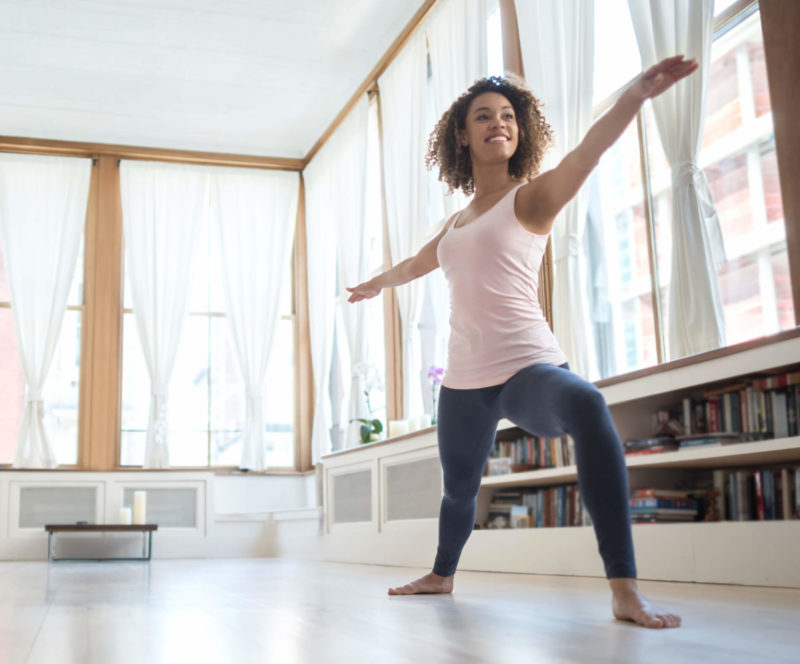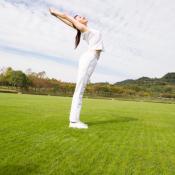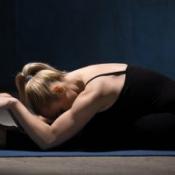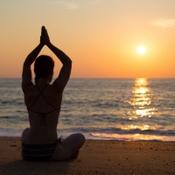 As a holistic psychotherapist who has had a daily yoga practice for almost 15 years, I am very well acquainted with the many ways yoga can support one’s emotional journey. Whether you are dealing with anxiety, anger, grief, depression, or feeling overwhelmed, yoga can cheer you up or soothe your soul.
As a holistic psychotherapist who has had a daily yoga practice for almost 15 years, I am very well acquainted with the many ways yoga can support one’s emotional journey. Whether you are dealing with anxiety, anger, grief, depression, or feeling overwhelmed, yoga can cheer you up or soothe your soul.
In addition to hatha yoga, the most commonly practiced form in the West, there is also yin, restorative, ashtanga, vinyasa, kundalini, and many other styles of this ancient spiritual art.
The following mini-primer describes some of the more mainstream types of yoga:
- Yin holds seated or prone poses to open the hips, pelvis, and lower spine. Poses are held for between three and five minutes. Yin targets connective tissues, such as the ligaments, bones, and even the joints of the body that normally are not exercised much in a more active style of asana practice. It is a meditative practice that allows you to go deeply into your body and breath.
- Restorative uses a variety of props to calm, rest, and soothe the body-mind. By feeling physically supported, tense muscles let go, and you can breathe more deeply and engage the parasympathetic nervous system (rest and digest).
- Ashtanga is a rigorous, choreographed style that wonderfully allows your mind to both focus and be free, especially if it is practiced regularly to the point of memorizing the sequence.
- Vinyasa is a hatha flow that goes seamlessly from one pose to the next.
- Kundalini uses Sanskrit mantras, breath work, and repetitive motions to energize the body and calm the nervous system.
All yoga focuses on the breath while building endurance, strength, and flexibility. Different styles can be used on different days, depending on how you feel.
The following are some ways yoga can support you:
Anxiety
Forward folds, inversions, alternate nostril breathing, and restorative yoga all can allay anxiety and calm the nervous system. The practice of yoga nidra (yogic sleep) is incredibly relaxing, even though the entire practice is done in corpse pose, lying on your back. Surprisingly, vigorous practices, such as kundalini and ashtanga, can also be helpful as they wring out excess energy. However, since they can ratchet up anxiety in some people, it is best to experiment and see what works for you.
Depression
Backbends, heart-opening poses, inversions, hatha vinyasa, kundalini, and ashtanga energize you and combat the fatigue that often accompanies depression. For depression with agitation, yin and restorative yoga work to both balance and revitalize your body-mind.
Grief
Grief is such a shape-shifter, cycling from depression to anger to anxiety to guilt, that all kinds of yoga can be beneficial, depending on the emotion of the moment. A standing and seated hatha vinyasa practice can be both enlivening and grounding, while alternate nostril breathing balances the left and right hemispheres of the brain.
Anger
Anger can feel both physically empowering and exhausting; so, depending on the way your anger is manifesting in your body, you may want to choose an energizing practice such as ashtanga, kundalini, or hatha vinyasa, or a relaxing, slower one such as yin or restorative. With slower yoga, there is more of an opportunity to tune in to what is fueling your anger and learn to sit with it while it moves through you.
Rumination
Inversions such as headstands and shoulder stands literally and figuratively turn your world upside down, which can be helpful in changing one’s view of any situation, especially one that has worn a rut in your brain. Twists beautifully wring out various emotional states and old ways of looking at things.
Feeling Overwhelmed
Generally speaking, a restorative or yin style is best to calm the adrenal glands and activate your parasympathetic nervous system. A 4-4-4 breath practice will also slow your heartbeat and can be done anywhere. (Breathe in to a count of four, retain your breath for a count of four, and exhale to a count of four. Five cycles of this is usually enough to have a noticeable effect.) Child’s pose and corpse pose both allow the nervous system to recover to some extent from life’s stresses, especially if they are held for five minutes or more.
All yoga can help you ride the waves of your emotions. By familiarizing yourself with a variety of yoga styles, you can tailor your practice to the challenge du jour.
References:
- Brown R.P., et al. (2005). Sudarshan Kriya Yogic Breathing in the Treatment of Stress, Anxiety, and Depression: Part I – Neurophysiologic Model. Journal of Alternative and Complementary Medicine, 11, No. 1, pp. 189–201.
- Brown R.P., et al. (2005). Sudarshan Kriya Yogic Breathing in the Treatment of Stress, Anxiety, and Depression: Part II – Clinical Applications and Guidelines. Journal of Alternative and Complementary Medicine, 11, No. 4, pp. 711–17.
- Janakiramaiah, N., et al. (2000). Antidepressant Efficacy of Sudarshan Kriya Yoga (SKY) in Melancholia: A Randomized Comparison with Electroconvulsive Therapy (ECT) and Imipramine. Journal of Affective Disorders, 57, No. 1–3, pp. 255–59.
- Khalsa, S.B. (2004). Yoga as a Therapeutic Intervention: A Bibliometric Analysis of Published Research Studies. Indian Journal of Physiology and Pharmacology, 48, No. 3, pp. 269–85.
- Kirkwood, G., et al. (2005). Yoga for Anxiety: A Systematic Review of the Research. British Journal of Sports Medicine, 39, No. 12, pp. 884–91.
- Pilkington, K., et al. (2005). Yoga for Depression: The Research Evidence. Journal of Affective Disorders, 89, No. 1–3, pp. 13–24.
- Saper, R.B., et al. (2004). Prevalence and Patterns of Adult Yoga Use in the United States: Results of a National Survey. Alternative Therapies in Health and Medicine, 10, No. 2, pp. 44–49.
- Streeter, C.C., Whitfield, T.H., Owen, L., et al. (2010). Effects of Yoga Versus Walking on Mood, Anxiety, and Brain GABA Levels: A Randomized Controlled MRS Study. Journal of Alternative and Complementary Medicine, 16(11):1145-1152. doi:10.1089/acm.2010.0007.
© Copyright 2016 GoodTherapy.org. All rights reserved. Permission to publish granted by Nicole S. Urdang, MS, NCC, DHM, Holistic Psychotherapy Topic Expert Contributor
The preceding article was solely written by the author named above. Any views and opinions expressed are not necessarily shared by GoodTherapy.org. Questions or concerns about the preceding article can be directed to the author or posted as a comment below.

 4 Iconic Yoga Positions and Their Therapeutic Benefits
4 Iconic Yoga Positions and Their Therapeutic Benefits How Yoga Can Help with Trauma Recovery, Part I
How Yoga Can Help with Trauma Recovery, Part I How Yoga Can Help with Trauma Recovery, Part II
How Yoga Can Help with Trauma Recovery, Part II